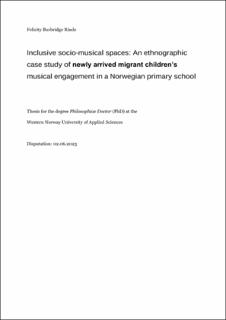Inclusive socio-musical spaces: An ethnographic case study of newly arrived migrant children’s musical engagement in a Norwegian primary school
Doctoral thesis
Published version

Åpne
Permanent lenke
https://hdl.handle.net/11250/3067180Utgivelsesdato
2023Metadata
Vis full innførselSamlinger
- Import fra CRIStin [3604]
- Institutt for kunstfag [264]
Sammendrag
This study explores the role of musical engagement in helping create an inclusive school environment for newly arrived migrant children in primary schools. The aim of the thesis is to contribute to existing knowledge on how music activities in school might help promote migrant education that has an ethos of inclusion, all the while conscious of the culturally bound nature of music education practices. It is an indepth study of how musical engagement plays out and is conceived as a tool for inclusion at one Norwegian primary school with a dedicated introductory class (IC) for newly arrived migrant children. The study seeks to highlight some of the obstacles to inclusivity that can arise in music activities in classrooms marked by cultural diversity, and offers a framework for analysing inclusive and exclusionary properties of musical engagement in school, in order to help overcome such obstacles.
The main research question at the centre of this doctoral project is: How might musical engagement help foster an inclusive school environment for newly arrived migrant children?
The chosen research design was an ethnographic case study with participatory elements. The case was Greenwood school (pseudonym), and the units of analysis were all settings at Greenwood that involved music with introductory class pupils, in the introductory class classroom and beyond. The main data collection instruments over ten months of fieldwork were participant observation, interviews with pupils, teachers and the school leadership, and field conversations with teaching staff.
Against the background of a review of international research literature as well as comprehensive fieldwork, I construct an analytical framework of open, inclusive socio-musical spaces. This draws on and combines the theoretical perspectives on interculturality, musical participation and inclusion which I applied to the child and teacher voices in the empirical material. The project investigates how newly arrived children’s musical engagement plays out in socio-musical spaces in school. It looks at what happens in these spaces, what kind of musical participation is possible in them, and the outcomes of participation in them. It also explores teacher and school leader perspectives on facilitating socio-musical spaces with and for newly arrived children to serve inclusive aims. This includes investigation of how these spaces are facilitated, on whose terms, and obstacles to such spaces being inclusive.
The main contribution of this study is the concept of addressing cultural diversity in the classroom through the facilitation of open, inclusive socio-musical spaces in schools, and my investigation of inclusive and exclusionary characteristics of such spaces. The findings show that while participation in socio-musical spaces in schools can serve inclusive purposes for newly arrived children, with beneficial outcomes such as experiences of belonging, feelings of community and a sense of achievement, it is by no means a given that all musical engagement has such outcomes.
An important finding is that music activities in school can have exclusionary effects when tacit expectations are coloured by majority-culture notions of what music is, or of acceptable ways of responding to music in the classroom. Similarly, while music can act as a marker of belonging in schools, the study illustrates how music in schools can also signal non-belonging and act as a marker of outsider status. The findings highlight pitfalls in music activities in culturally diverse classrooms, such as not taking into consideration the needs and resources of newly arrived children, and rarely moving beyond reproductive music activities centred in the majority culture.
The study concludes that there are a number of potential obstacles at the individual, organisational and discursive level to the facilitation of open, inclusive socio-musical spaces. Discursive obstacles can lead to blindspots in practice, for instance linked to tacit knowledge, majority privilege, and teachers’ and school leaders’ construction of the concepts of music and inclusion. The findings suggest that intercultural competence and cultural humility are necessary to address such obstacles in order to realise inclusive spaces in culturally diverse classrooms. An important implication of this study is that if socio-musical spaces in schools are to realise their inclusive potential for meeting cultural diversity in the classroom, teachers need to be aware of how certain music activities can reinforce markers of belonging and non-belonging. It is recommended that reproductive music activities are complemented with collaborative, creative music activities not tied to specific cultural categories.
Består av
Rinde, F. B., & Christophersen, C. (2021): Developing an understanding of intercultural music education in a Nordic setting, Nordic Research in Music Education, 2(2), 5-27. https://doi.org/10.23865/nrme.v2.2772Rinde, F. B., & Kenny, A. (2021): Music in the school life of newly arrived migrant children: potential paths to participation and belonging, Music Education Research, 23(5), 622-633. https://doi.org/10.1080/14613808.2021.1993165
Rinde, F. B. (2022): Inclusive socio-musical spaces for newly arrived migrant children in a Norwegian primary school: teacher and school leader perspectives, International Journal of Music Education, 0(0). https://doi.org/10.1177/02557614221115878